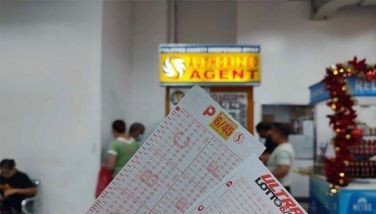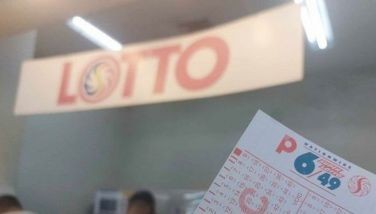All eyes on the US, the center of the ‘financial’ universe
July 10, 2006 | 12:00am
"We now live in a global financial world that when the US sneezes, the rest of the world catches a cold (Philequity Corner, May 22, 2006)." The reverse is also true. When the biggest market in the world recovers, the rest of the world recoups with vigor.
Unlike past market corrections, the sharp decline in global equity markets in May-June did not reflect a change in long-term fundamentals. Absent was the irrational exuberance in equity price valuation that we experienced in April 2000. Nor was there a loss of confidence in emerging market economies saddled with huge current account deficits experienced during the Asian crisis in 1997. In fact, equity valuations today are reasonably in line with long-term fundamentals and the emerging market economies have significant current account surpluses and are in strong financial standing.
What the markets experienced in May, rather, was a re-pricing of risk given rising geo-political tensions (over Iran & North Korea’s nuclear ambitions) and most of all, the higher costs of capital around the globe as central banks (especially the US Fed) tighten their grip on liquidity.
Equity markets, however, recovered following the US Federal Open Market Committee (FOMC) meeting last June 29. The 25 basis points rise in US Fed rates did not come as a surprise but the slight tweak in wording in the official FOMC statement caused the positive market reaction. In a nutshell, what the statement alluded to are the following:
The FOMC sees that economic growth is moderating.
The housing market is coming under pressure.
And, further tightening will depend on coming inflation and economic data.
US equity prices have since rallied as aggressive tightening expectations receded. Following an 8.3-percent decline in the Dow Jones Industrial Average and a 7.3-percent fall in the S&P500 Index in May-June, the indices recovered 3.7 percent and 2.9 percent, respectively, from their June lows.
Taking the lead from the US, equity prices in developed markets such as Japan, France, Germany, and the UK have since rallied an average of 8.4 percent. In Asia, the top three performers – India, the Philippines and Indonesia – have gained an average of 13.6 percent from their June lows. Note that these three performed well not only because they fell the hardest in May, but because they were consistently the best performers prior to the sell-off.
Concurrent with the fall in the equities markets in May-June, most currencies (if not all) also declined against the US dollar. As you can see from the table above, the primary currencies depreciated an average of 5.5 percent against the dollar, while Asian currencies dropped 4.1 percent. In a synchronized move, all the currencies then rallied against the dollar when the dollar peaked in June. Similarly, metal commodities such as gold, silver and copper fell in May-June and has recovered since. Every asset market, seemingly, is doing a one-way trade against the dollar.
Thus, all eyes will be on the US Fed and on how they will be perceived to react on the tons of economic data that will be released between now and the next Fed meeting on Aug. 8. Below is a list of key US economic announcements/events that Philequity will be closely watching.
Incidentally, data on the non-farm payrolls released last Friday had mixed messages. Despite a moderation in job growth in June, there were some signs of inflationary pressures as average hourly wages increased at its fastest pace since June 2001.
Fundamental support for a positive case in the Philippines is very much valid both structurally and cyclically. Fiscal consolidation has progressed well. The government has so far narrowed its Jan-May 2006 deficit to P44.2 billion from P67.8 billion last year. Good economic growth prospects, a stable peso, low interest rates, and subsiding inflation still provide the cyclical support. Economic Planning Secretary Romulo Neri recently said that the government expects the economy to expand "near" six percent in the three months to June, the fastest in seven quarters. Meanwhile, inflation slowed to a five-month low of 6.7 percent in June, and the peso-dollar rate has stabilized back towards the 52:$1 levels, giving the BSP the leeway to keep interest rates relatively low.
While global markets may continue to be volatile over the next couple of months, we maintain our long-term positive view on the Philippines. Macro risks, therefore, are mainly external, as investors try to digest all the US economic data going into the US Fed meet in August. Nonetheless, we believe that the Fed Funds rate is very close to peaking (give or take another 25 basis points hike in August) and that equities markets have made an intermediate bottom last June. Barring unforeseen events, Philequity’s year-end target for the PSEi remains at 2,600 – still a decent 15 percent upside from current levels.
For comments and inquiries, you can email us at [email protected] or [email protected]
Unlike past market corrections, the sharp decline in global equity markets in May-June did not reflect a change in long-term fundamentals. Absent was the irrational exuberance in equity price valuation that we experienced in April 2000. Nor was there a loss of confidence in emerging market economies saddled with huge current account deficits experienced during the Asian crisis in 1997. In fact, equity valuations today are reasonably in line with long-term fundamentals and the emerging market economies have significant current account surpluses and are in strong financial standing.
What the markets experienced in May, rather, was a re-pricing of risk given rising geo-political tensions (over Iran & North Korea’s nuclear ambitions) and most of all, the higher costs of capital around the globe as central banks (especially the US Fed) tighten their grip on liquidity.
Equity markets, however, recovered following the US Federal Open Market Committee (FOMC) meeting last June 29. The 25 basis points rise in US Fed rates did not come as a surprise but the slight tweak in wording in the official FOMC statement caused the positive market reaction. In a nutshell, what the statement alluded to are the following:
The FOMC sees that economic growth is moderating.
The housing market is coming under pressure.
And, further tightening will depend on coming inflation and economic data.
US equity prices have since rallied as aggressive tightening expectations receded. Following an 8.3-percent decline in the Dow Jones Industrial Average and a 7.3-percent fall in the S&P500 Index in May-June, the indices recovered 3.7 percent and 2.9 percent, respectively, from their June lows.
Taking the lead from the US, equity prices in developed markets such as Japan, France, Germany, and the UK have since rallied an average of 8.4 percent. In Asia, the top three performers – India, the Philippines and Indonesia – have gained an average of 13.6 percent from their June lows. Note that these three performed well not only because they fell the hardest in May, but because they were consistently the best performers prior to the sell-off.
Concurrent with the fall in the equities markets in May-June, most currencies (if not all) also declined against the US dollar. As you can see from the table above, the primary currencies depreciated an average of 5.5 percent against the dollar, while Asian currencies dropped 4.1 percent. In a synchronized move, all the currencies then rallied against the dollar when the dollar peaked in June. Similarly, metal commodities such as gold, silver and copper fell in May-June and has recovered since. Every asset market, seemingly, is doing a one-way trade against the dollar.
Thus, all eyes will be on the US Fed and on how they will be perceived to react on the tons of economic data that will be released between now and the next Fed meeting on Aug. 8. Below is a list of key US economic announcements/events that Philequity will be closely watching.
Incidentally, data on the non-farm payrolls released last Friday had mixed messages. Despite a moderation in job growth in June, there were some signs of inflationary pressures as average hourly wages increased at its fastest pace since June 2001.
While global markets may continue to be volatile over the next couple of months, we maintain our long-term positive view on the Philippines. Macro risks, therefore, are mainly external, as investors try to digest all the US economic data going into the US Fed meet in August. Nonetheless, we believe that the Fed Funds rate is very close to peaking (give or take another 25 basis points hike in August) and that equities markets have made an intermediate bottom last June. Barring unforeseen events, Philequity’s year-end target for the PSEi remains at 2,600 – still a decent 15 percent upside from current levels.
For comments and inquiries, you can email us at [email protected] or [email protected]
BrandSpace Articles
<
>
- Latest
- Trending
Trending
Latest
Trending
Latest
Recommended




























